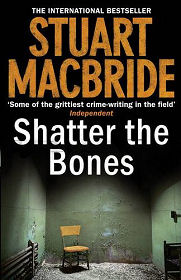 |
Stuart MacBride's "Shatter the Bones" takes the granite city of Aberdeen as its setting, and Grampian Police as the source of its main characters. Detective Sergeant Logan McRae is not having a good time of it. A young female drug addict in the cells has accused him of rape, having been told to do so by whoever wrote his name on her chest so she wouldn't forget it: and however unlikely the claim, it has to be investigated. And meanwhile McRae's police pool car is stolen by a junkie with a very large Doberman. He is not a popular man with his superiors.
But all this is (perhaps) incidental to the main plot of this excellent novel, which follows the efforts of the police to unravel a crime that is very much of our times. A mother and daughter singing duet, semi-finalists in a popular TV talent show, have been kidnapped, and their captors are threatening to kill them unless the viewers of the show come up with enough money to save them. The kidnappers have left no clues and the police are struggling to save the lives of the captives in an investigation carried out in the full glare of an intense media spotlight.
Crime fiction tends to lie somewhere on a spectrum that has at one end detectives whose solo genius is usually sufficient, people like Sherlock Holmes who simply take note of the circumstances, think deeply for a while, and solve the crime to the astonishment of the mere mortals around them. Stuart MacBride is very much at the other end of the spectrum. His police investigation of the kidnapping is all about the systematic analysis of many different factors by a large team, and the huge amount of work it takes to narrow down possibilities and lead, hopefully, to the breakthrough that might produce a result. Most crime fiction tends to the solo end of the spectrum, perhaps because it is where the roots of the genre evolved, and perhaps also because it can make for a more compelling story if the central character is in control.
Not in the skillful hands of Stuart MacBride, however. He tells the story of the evolving investigation, largely from the point of view of DS McRae, with a compelling sense of realism that draws you into the book and keep you turning the pages. His style is deeply gritty, and the story is told in a way that feels like it has been captured by a fly on the wall documentary maker using hand-held cameras. Rough edges abound in the dialogue and in the detail of the settings, and there are no heroes here: just very believable and often flawed characters doing the best they can in difficult circumstances.
InformationHardcover: 448 pagesHarperCollins www.harpercollins.co.uk 6 January 2011 ISBN-10: 000734421X ISBN-13: 978-0007344215 Size: 23.6 x 14.7 x 3.8 cm Buy from Amazon (paid link) Visit Bookshop Main Page |
